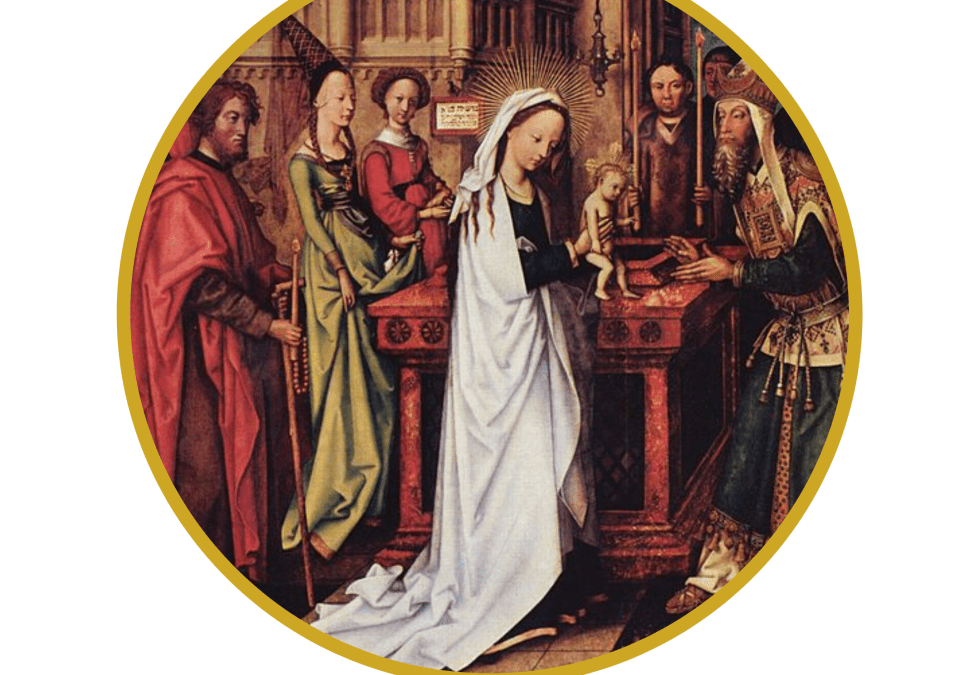2 February: Feast of the Presentation of the Lord. Also known as Candlemas, this feast commemorates three distinct but related historical events in the life of the Holy Family. It marks the day when Mary and Joseph brought baby Jesus to the temple in Jerusalem, exactly 40 days after his birth. The Mosaic Law required them to consecrate their firstborn son to God (Exodus 13). Additionally, the law required Mary to submit to ritual purification forty days after childbirth (Leviticus 12:2-8). The ritual involved making a sacrificial offering in the temple. The Gospel of Luke tells us that as Mary and Joseph were poor, they took the option provided for those who could not afford a lamb, sacrificing “a pair of turtledoves, or two young pigeons” (Luke 2:22-24). Neither Mary (perfectly pure and conceived without sin) nor Jesus (God himself) were in need of being purified and consecrated to God; however, they submitted themselves in perfect obedience to God and to the Law of Moses. Our current church calendar focuses this day on the Presentation but in previous eras the Church highlighted the Purification of Mary. {There also used to be a Church custom of “churching” or blessing women forty days after childbirth. It reintroduced the woman to society after her period of recovery at home. Today, churching has disappeared as a custom and now blessing of the mother takes place at the baby’s baptism ceremony.} Today’s feast also commemorates the encounter in the temple between the Holy Family and Saint Simeon the prophet and Saint Anna the prophetess. This is the third and final infancy epiphany of Jesus (the first was to the Hebrew shepherds; the second to the Gentile kings; this third one to the elders of the Israelites). The next epiphany in the life of Jesus will be to the public, at his Baptism in the Jordan. Today’s feast is known by the title Candlemas because of the words of Saint Simeon when he met the child Jesus in the temple: “For my eyes have seen your salvation which you have prepared in the presence of all peoples, a light for revelation to the Gentiles, and for glory to your people Israel” (Luke 2:30-32). Jesus is the Light of the World, the Messiah who has come not just for the Jew but the gentile; not just the righteous, but the sinner. On this feast day, the Church blesses candles for use throughout the year (this has been a church tradition at least since the seventh century). Traditionally, families also bring their own candles to church to be blessed on this feast. The candles represent the fact that the light of the world is here; the light is coming into a dark world as the Church calendar progresses towards the brightness of Easter.
Ideas for celebrating this feast day:
- Go to mass and bring a stack of candles to be blessed for use over the next year! Prince of Peace has mass and blessing of the candles at 8:30am and 7pm on 2 February.
- If you are unable to go to mass, do a family Candlemas procession and prayer at home. Instructions here.
- Candlemas is known in France as “crepe day”. Make savory crepes for dinner (use whole wheat flour and fill them with ham, cheese, etc.) and sweet crepes for dessert (use white flour and top them with fruit, chocolate, whipped cream).
- A Candlemas tradition is to spend the day without electric lights – or at least to eat dinner only by candlelight (using your blessed candles!)
- Say a family rosary by candlelight; the Presentation in the Temple is one of the Joyful Mysteries.
- Meditate on the constant fiatof Our Lady of Sorrows, who embraced the will of God even as Simeon predicted that a sword would pierce her heart.
- If you haven’t taken down your Christmas decorations yet, today’s the day! Candlemas marks the very end of the liturgical season of Christmas.
- Read this articleto learn about the connection between Candlemas and Groundhog Day.
- Read Fr. Butler’s article: The Purification, Commonly called Candlemas-Day and Pope St. JP II’s article: Presentation Prefigures the Cross.
(Sources: catholicculture.org; Catholic All Year Compendium by K. Tierney; Catholicstraightanswers.com)

Recent Comments